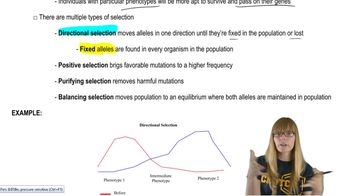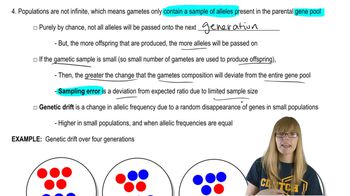Table of contents
- 1. Introduction to Genetics51m
- 2. Mendel's Laws of Inheritance3h 37m
- 3. Extensions to Mendelian Inheritance2h 41m
- 4. Genetic Mapping and Linkage2h 28m
- 5. Genetics of Bacteria and Viruses1h 21m
- 6. Chromosomal Variation1h 48m
- 7. DNA and Chromosome Structure56m
- 8. DNA Replication1h 10m
- 9. Mitosis and Meiosis1h 34m
- 10. Transcription1h 0m
- 11. Translation58m
- 12. Gene Regulation in Prokaryotes1h 19m
- 13. Gene Regulation in Eukaryotes44m
- 14. Genetic Control of Development44m
- 15. Genomes and Genomics1h 50m
- 16. Transposable Elements47m
- 17. Mutation, Repair, and Recombination1h 6m
- 18. Molecular Genetic Tools19m
- 19. Cancer Genetics29m
- 20. Quantitative Genetics1h 26m
- 21. Population Genetics50m
- 22. Evolutionary Genetics29m
21. Population Genetics
Hardy Weinberg
Problem 11a
Textbook Question
Figure 20.6 illustrates the effect of an ethanol-rich and an ethanol-free environment on the frequency of the Drosophila allele in four populations in a 50-generation laboratory experiment. Population 1 and population 2 were reared for 50 generations in a high-ethanol environment, while control 1 and control 2 populations were reared for 50 generations in a zero-ethanol environment. Describe the effect of each environment on the populations, and state any conclusions you can reach about the role of any of the evolutionary processes in producing these effects.
 Verified step by step guidance
Verified step by step guidance1
<Step 1: Identify the key variables in the experiment. The main variables are the ethanol-rich environment and the ethanol-free environment, and the frequency of the Drosophila allele in each population.>
<Step 2: Analyze the changes in allele frequency in populations 1 and 2, which were exposed to the high-ethanol environment. Consider how the presence of ethanol might have influenced natural selection, genetic drift, or other evolutionary processes.>
<Step 3: Examine the changes in allele frequency in control populations 1 and 2, which were kept in a zero-ethanol environment. Determine if there were any significant changes in allele frequency and what evolutionary processes might explain these changes.>
<Step 4: Compare the results from the ethanol-rich environment with those from the ethanol-free environment. Look for patterns or differences in allele frequency changes that could indicate the influence of the environment on evolutionary processes.>
<Step 5: Draw conclusions about the role of evolutionary processes such as natural selection, genetic drift, or gene flow in the observed changes in allele frequency. Consider how the presence or absence of ethanol might have acted as a selective pressure or influenced other evolutionary mechanisms.>
Recommended similar problem, with video answer:
 Verified Solution
Verified SolutionThis video solution was recommended by our tutors as helpful for the problem above
Video duration:
1mPlay a video:
Was this helpful?
Key Concepts
Here are the essential concepts you must grasp in order to answer the question correctly.
Natural Selection
Natural selection is a fundamental mechanism of evolution where individuals with advantageous traits are more likely to survive and reproduce. In the context of the Drosophila populations, the ethanol-rich environment may favor alleles that confer tolerance to ethanol, leading to an increase in their frequency over generations. This process illustrates how environmental pressures can shape genetic variation within a population.
Recommended video:
Guided course

Natural Selection
Genetic Drift
Genetic drift refers to random changes in allele frequencies within a population, particularly in small populations. In the Drosophila experiment, if the populations are small, random fluctuations could significantly impact the frequency of alleles, regardless of their adaptive value. This concept highlights the role of chance in evolution, especially in isolated or controlled environments.
Recommended video:
Guided course

Genetic Drift
Phenotypic Plasticity
Phenotypic plasticity is the ability of an organism to change its phenotype in response to environmental conditions. In the Drosophila study, the populations may exhibit different traits based on the ethanol levels, which could influence survival and reproduction. Understanding this concept is crucial for interpreting how environmental factors can lead to observable changes in populations over generations.
Recommended video:
Guided course

Mutations and Phenotypes

 13:4m
13:4mWatch next
Master Hardy Weinberg with a bite sized video explanation from Kylia Goodner
Start learningRelated Videos
Related Practice


